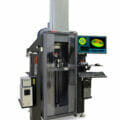Set to be worth $90 billion by 2050[1], the electric vertical take-off and landing (eVTOL) and Urban Air Mobility markets are set to change the future of flying in the coming years. For the industry to really make its mark, production of eVTOL aircraft will need to ramp up, imitating the automated production lines seen in the manufacture of electric cars and in the aerospace industry. To this end, robotics and automation specialist FANUC is poised to enter the Urban Air Mobility market, offering eVTOL companies a range of automated solutions backed by in-depth knowledge of how to scale up production and fast-track their way to success. Bob Struijk, FANUC’s European Vice President, reveals more…
Over the last 10 years, demand for robotics has been increasing steadily, but it really ramped up after COVID-19, partly due to a shortage of manual labour. At FANUC we manufacture over 9,000 robot units a month – and it’s still not enough!

The benefits of automation are well documented. A robot can work 24/7 and still complete its task perfectly. It never gets tired, needs a break or goes off sick. By giving heavy, repetitive or ultra-precise jobs to a robot – such as drilling, riveting or machining parts, or moving, loading and unloading components – companies can free up their employees to work on more value-added tasks, increase the quality and consistency of their output, and boost their productivity. Of course, to work effectively, a robot first needs to be set up well; that’s the trick with automation. You need good controls, but once a robot has been programmed correctly, off it goes!
The right robot for the job
Compared to even a few years ago,people talk a lot about robotics, but not many have been exposed to it. Plant and factory managers know about automation and even understand some of the key benefits, but immediate day-to-day issues often take priority over mid- to long-term planning. As a result, decision makers are often unaware of the sheer variety of robotics on offer, and the kind of tasks that can be automated.
In the past, the belief was that robots are only suitable for large operations. Maybe that was true in the 1980s and 90s, but not anymore. The sector has moved on significantly in the last few years and our portfolio is now much wider. For example, while for some applications, a high-speed, large robot that can carry extremely heavy payloads will be required. Meanwhile other applications will require our range of collaborative robots (cobots). These are built with softer areas of contact and operate at a slower pace. When a worker comes into contact with a cobot, the cobot will immediately stop, which allows for safe co-working.
Collaborative working
When considering combining human and robotic workers, first we must ask ourselves, what are humans good at? We have eyes to see, hands to feel and touch, can easily combine and recognise things, and can carry out very difficult tasks that may not be obvious for a robot. But we’re not so good at repetition and maintaining a high standard of quality for a long time. Equally, we’re not great at lifting things and putting them into a machine; and more importantly, people do not want to do that kind of job anymore.
This is where cobots come in. Working alongside humans, they can complete monotonous, repetitive jobs that require consistency and precision, freeing up the employee to complete more value-added tasks.
Another good thing about a cobot is how quick easy it is to programme. It’s like using a smartphone; you simply move it into position and tell it to do different tasks. It can be programmed in 10 minutes and, depending on the application, cobots often don’t need to be fenced off; so, there are a lot of benefits to them.
Automating eVTOL production
For the aerospace industry, eVTOL aircraft are the next frontier. The Tesla car might look like a normal car on the outside but inside, it’s a totally different story. From a manufacturing perspective, electric vehicles require a battery pack and the powertrain is completely different, too. Plus, there is no gearbox. The manufacturing side of eVTOL aircraft is therefore different to that of an Airbus A320 or Boeing 737.
Fortunately, we are in a strong position thanks to our work with electric vehicle manufacturers. Like electric cars, eVTOL are comprised of lightweight materials – carbon fibre, plastics, etc – and are electrically driven. Of course, there will be some challenges, but we’re ready for that as we’re used to solving manufacturers’ challenges. At our headquarters in Coventry, we have the facility to carry out demonstrations and undertake proof-of-concept testing. Once we can understand the problem, it’s often quite easy to come up with a solution. We’re very much looking forward to bringing this approach to the Urban Air Mobility market and helping manufacturers scale up their production of eVTOL aircraft.
Prioritising R&D
In addition, we use our own manufacturing platform as an R&D testbed. Our robots are born in our factories and are in turn made by other FANUC robots. In our manufacturing facilities, we have 5,000 robot workers and only 600-700 human workers. The ratio is almost 8:1, so our employees have been redeployed to more value-added tasks. We’re constantly developing our offering to further automate our own factories – and if it’s good enough for us, then it’s good enough for our customers.
[1] eVTOL Insights Power Book 2021








